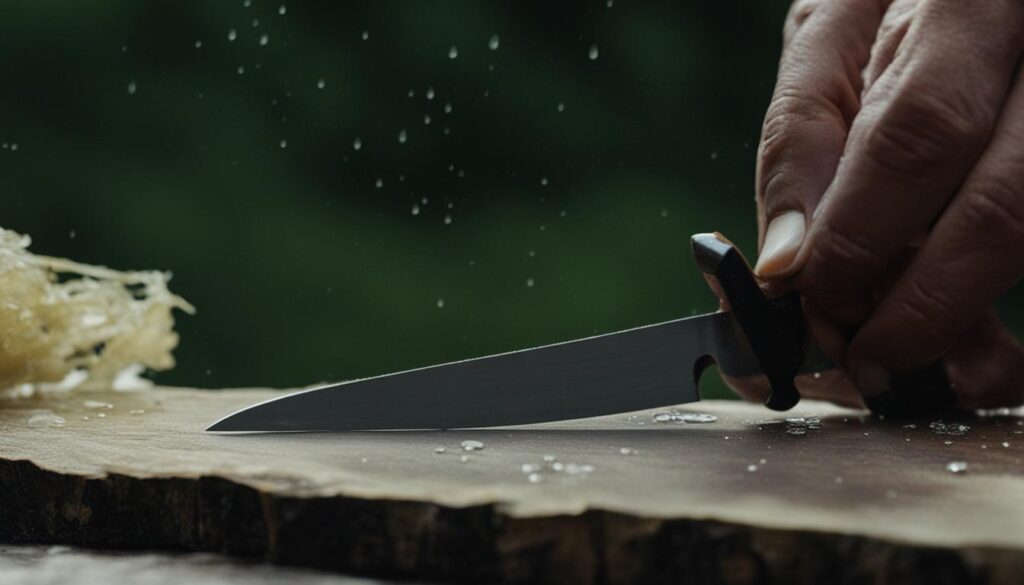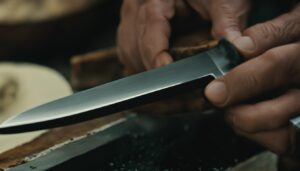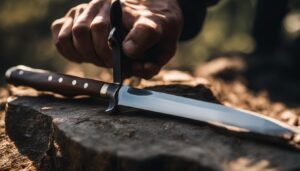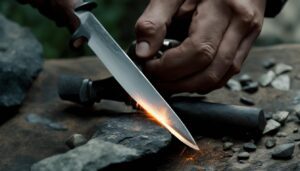Hunting knives are crucial tools for hunters, but over time, they can lose their sharpness. Sharpening a hunting knife is a skill that every outdoorsman should master, as it not only helps maintain the knife’s performance and durability but also ensures safety and efficiency. Whether you’re a beginner or have some experience, this guide will provide you with essential knowledge and techniques for effectively sharpening your hunting knife.
Key Takeaways:
- Become familiar with different types of hunting knives and their specific sharpening requirements.
- Choose the right sharpening tool for your hunting knife, such as sharpening stones, honing rods, or electric sharpeners.
- Properly clean and prepare your hunting knife before sharpening to achieve optimal results.
- Maintain a consistent sharpening angle to avoid damaging the blade.
- Regularly sharpen and maintain your hunting knife to keep it sharp and reliable for longer periods.
How the Type of Knife Affects the Sharpening Process
When it comes to sharpening hunting knives, the type of knife you have will determine the specific sharpening techniques required. Different blade designs pose unique challenges and may require specialized tools to achieve optimal results.
Let’s take a closer look at how different types of hunting knives affect the sharpening process:
Drop Point Knife
This type of knife features a curved edge, making it ideal for skinning and slicing. When sharpening a drop point knife, it’s important to use a sharpening stone or honing rod with a rounded edge to follow the blade’s curve. This allows for precision and maintains the knife’s functionality.
Clip Point Knife
Clip point knives have a straight edge with a sharp, pointed tip. While they are generally easier to sharpen, special care must be taken not to over-sharpen the tip, as it can weaken the blade. It’s essential to maintain the proper angle and avoid removing too much material from the blade.
Gut Hook Knife
Gut hook knives are designed specifically for field dressing game. They feature a unique hook-shaped blade that requires special attention when sharpening. The hook’s edge should be sharpened separately, using a small sharpening stone or rod. This ensures that the hook remains sharp and effective when navigating through tough game skin.
Bowie Knife
Bowie knives are known for their long, curved blades. Sharpening a Bowie knife can be more challenging due to its size and shape. It may require a longer sharpening tool to effectively sharpen the entire length of the blade. Taking your time and maintaining a consistent angle are key to achieving a sharp edge.
Skinning Knife
Skinning knives are typically designed with a narrow blade for precision and control. While they may be easier to sharpen, the thinness and flexibility of the blade may require more frequent sharpening. It’s important to find the right balance between sharpness and durability.
Understanding the unique characteristics of each hunting knife type and using the appropriate sharpening techniques will help you maintain the sharpness and functionality of your knives. Whether you’re field dressing game or performing other hunting tasks, a properly sharpened knife is essential for a successful hunting trip.
Table: Sharpening Challenges for Different Hunting Knife Types
| Knife Type | Sharpening Challenges |
|---|---|
| Drop Point Knife | Ensuring a consistent curve while sharpening |
| Clip Point Knife | Avoiding over-sharpening the tip |
| Gut Hook Knife | Sharpening the hook’s edge separately |
| Bowie Knife | Sharpening the entire length of the curved blade |
| Skinning Knife | Frequent sharpening due to thinness and flexibility |
Each hunting knife type presents its own set of sharpening challenges. By understanding these challenges and using the right techniques, you can ensure that your hunting knives are sharp, reliable, and ready for any task that comes your way.
Different Types of Sharpening Tools
When it comes to sharpening hunting knives, there are several different types of sharpening tools available. Each tool has its own advantages and disadvantages, so it’s important to understand the differences and choose the right one for your needs.
Sharpening Stones
One of the most traditional and versatile sharpening tools is the sharpening stone, also known as a whetstone. Sharpening stones come in different materials such as natural stone, diamond stone, ceramic stone, and synthetic stone. They require the user to apply oil or water to the surface before sharpening and can be used for all types of hunting knives. Sharpening stones allow for precise control and can produce a razor-sharp edge when used correctly.
Honing Rods
Honing rods are long cylindrical rods made of steel or ceramic. Unlike sharpening stones, honing rods are used to maintain a sharp edge rather than sharpening it. They can be used for all types of hunting knives and are ideal for regular maintenance. Honing rods are easy to use and can help restore a knife’s sharpness quickly and efficiently.
Electric Sharpeners
For those looking for a quick and easy sharpening solution, electric sharpeners are a popular choice. These sharpening tools feature abrasive belts or discs that grind away dull areas on the blade’s edge. Electric sharpeners are convenient and can produce consistent results, but they may remove more material from the blade compared to other sharpening methods.
Pull-Through Sharpeners
If portability is a priority, pull-through sharpeners are a great option. These compact tools feature two sharpening stones that are pulled through the blade to sharpen it. Pull-through sharpeners are easy to use and are suitable for beginners. However, they may not provide as precise results as other sharpening methods.
Guided Sharpening Systems
Guided sharpening systems are perfect for those who want to ensure a consistent sharpening angle. These systems feature a sharpening stone or rod mounted on a guide, which helps maintain a consistent angle while sharpening. Guided sharpening systems are user-friendly and produce excellent results. However, they may require a larger investment compared to other sharpening tools.
Choosing the Right Sharpening Tool
When choosing the right sharpening tool for your hunting knife, it’s important to consider your skill level, personal preferences, and the type of knife you have. Sharpening stones offer precision and control, while honing rods are ideal for maintenance. Electric sharpeners provide convenience, pull-through sharpeners offer portability, and guided sharpening systems ensure consistent results. Experimenting with different tools and techniques can help you find the one that works best for you.
Preparing Your Hunting Knife For Sharpening
Cleaning the blade of your hunting knife is an essential step before sharpening. To ensure optimal results, use a clean, damp microfiber cloth to remove any dirt, debris, or residue that may be on the blade. This will prevent any particles from interfering with the sharpening process and ensure a clean and precise cut.
Once the blade is clean, it’s important to check for any nicks, chips, or other damage. These imperfections can affect the overall performance of the knife and may require additional attention. If you notice any nicks or chips, use a file to carefully smooth them out, ensuring a smooth and even cutting edge.
Determining the sharpening angle is crucial to avoid damaging your blade. Refer to the manufacturer’s recommendations for the correct angle, or use a sharpening guide if one is available. If the manufacturer has not specified the angle, you can use a simple coin trick to determine the angle. Place a coin on the blade’s edge and adjust the angle until the coin is resting on the blade without falling off. This will give you a good approximation of the correct sharpening angle.
Choosing the right sharpening method is the next step in preparing your hunting knife. There are various methods available, such as sharpening stones, electric sharpeners, or sharpening rods. Each method has its advantages and disadvantages, so consider your skill level and the type of knife you’re sharpening when making your selection. Experimentation may be needed to find the method that works best for you.

Cleaning the Blade
- Use a clean, damp microfiber cloth to remove dirt, debris, and residue from the blade.
Checking for Nicks and Chips
- Inspect the blade for any nicks, chips, or damage that may affect its performance.
- Use a file to carefully smooth out any imperfections, ensuring a smooth cutting edge.
Determining the Sharpening Angle
- Refer to the manufacturer’s recommendations for the correct sharpening angle.
- Use a sharpening guide or the coin trick to determine the angle if it is not specified.
Choosing a Sharpening Method
- Consider your skill level and the type of knife when selecting a sharpening method.
- Experiment with different methods, such as sharpening stones, electric sharpeners, or sharpening rods, to find the one that works best for you.
By properly preparing your hunting knife for sharpening, you can ensure optimal results and maintain the performance of your knife. Cleaning the blade, checking for nicks and chips, determining the sharpening angle, and choosing the right sharpening method are all essential steps in the process. With the right preparation and technique, you’ll be able to keep your hunting knife sharp and ready for any outdoor adventure.
Conclusion
Sharpening hunting knives is a crucial skill for every hunter. It not only enhances the performance and efficiency of the knife but also ensures safety during outdoor activities. By maintaining a sharp hunting knife, I can enjoy clean and precise cuts, making tasks like field dressing and skinning easier and safer.
Understanding the importance of knife sharpening is key to becoming a skilled hunter. Regular maintenance and sharpening are necessary to keep the blade in optimal condition. By mastering the art of sharpening, I can maintain a sharp hunting knife for longer periods of time, ensuring its durability and longevity.
Developing sharpening skills is a continuous process that requires experimentation with different techniques and tools. Each individual may find a unique approach that works best for them. With practice and patience, I can improve my sharpening skills and enjoy the benefits of a well-maintained hunting knife. So, let’s sharpen those skills and stay prepared for the next hunting adventure!
FAQ
Why is sharpening a hunting knife important?
Sharpening a hunting knife is important because it helps maintain the knife’s performance, durability, safety, and efficiency. It ensures a clean and precise cut, making field dressing, skinning, and other tasks easier and safer.
What are the different types of hunting knives and their sharpening techniques?
Different types of hunting knives, such as drop point, clip point, gut hook, Bowie, and skinning knives, require different sharpening techniques. Each type may require specific tools or methods to sharpen the blade effectively.
What are the different types of sharpening tools available for hunting knives?
There are various sharpening tools available for hunting knives, including sharpening stones (whetstones), honing rods, electric sharpeners, pull-through sharpeners, and guided sharpening systems. Each tool has its advantages and disadvantages, and the choice depends on personal preferences and the type of knife being sharpened.
How do I prepare my hunting knife for sharpening?
To prepare your hunting knife for sharpening, start by cleaning the blade with a clean, damp microfiber cloth. Check for nicks, chips, or any other damage on the blade, and use a file to smooth them out. Determine the sharpening angle using manufacturer recommendations or a sharpening guide. Finally, choose the appropriate sharpening method for your knife.
How often should I sharpen my hunting knife?
The frequency of sharpening your hunting knife depends on how often you use it and how dull it becomes. It’s recommended to regularly sharpen the blade to maintain optimal performance. Observing the knife’s sharpness and conducting regular maintenance will help you determine when it’s time to sharpen your knife.





